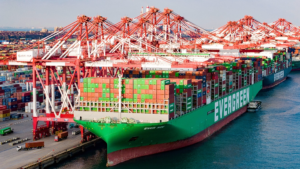‘Fight to the end,’ why China won’t back down from U.S. tariff hikes
In just a few days, the U.S.-China tariff dispute has intensified dramatically.
On April 2, the U.S. imposed a 34-percent “reciprocal tariff” on Chinese imports, following earlier hikes from 10 percent in February to 20 percent in March. In response, China quickly retaliated on April 4 with matching tariffs on U.S. goods. This move triggered a sharp escalation from U.S. President Donald Trump, who imposed an additional 50 percent tariff on Chinese imports, bringing the total to 104 percent.

China’s response was swift: it raised tariffs on U.S. goods from 34 percent to 84 percent, placed 12 U.S. entities under export controls and added six companies to the “unreliable entity” list. Trump, however, countered by raising tariffs on Chinese goods to 125 percent while announcing a 90-day delay for tariffs on other countries.
China does not want to fight trade and tariff wars, but will not flinch when a trade and tariff war comes, the Foreign Ministry said.
With tensions rising, the question now is, how should one interpret China’s response and position in this escalating trade dispute?
China’s systematic view on trade ties with U.S.
China released a white paper recently outlining its view of the bilateral trade relationship.
A key message was clear: economic ties between China and the U.S. should not be judged solely by the goods trade imbalance. Instead, a more comprehensive framework – including goods trade, services trade and local sales by each country’s enterprises – should be taken to assess the economic relationship.
According to the U.S. Department of Commerce, China’s share of the U.S. goods trade deficit has dropped for six consecutive years – from 47.5 percent in 2018 to 24.6 percent in 2024. Meanwhile, the U.S. enjoys a substantial advantage in services trade.
From 2001 to 2023, bilateral services trade surged from $8.95 billion to $66.86 billion, a sixfold increase. In 2023 alone, the U.S. ran a $26.57-billion services trade surplus with China. Additionally, U.S. companies operating in China recorded $490.52 billion in sales in 2022, compared to $78.64 billion for Chinese companies in the U.S.
“China adopts a systematic way of thinking – looking at the whole picture. The U.S., however, tends to focus only on aspects that seem unfavorable to itself, often exaggerating them while ignoring the benefits,” said Gao Lingyun, a researcher at the Chinese Academy of Social Sciences.
He further noted that if the U.S. persists in escalating tensions, China has ample tools for counteraction, including in the services trade sector. Nevertheless, any countermeasures would be carefully calibrated to minimize domestic impact.
U.S. domestic challenges drive external pressure
China also views the U.S. tariff strategy as a means of shifting blame for internal economic challenges.
While the China-U.S. Phase One trade agreement signed in January 2020 emphasized mutual respect and resolution of disputes through dialogue, the U.S. has since imposed multiple restrictive measures that China believes violate the agreement.
For example, in October 2022, the U.S. imposed sweeping controls on semiconductor exports to China. That same year, Chinese imports of U.S. semiconductors and semiconductor manufacturing equipment dropped by 23 percent and 17.9 percent, respectively.
Similarly, Boeing’s aircraft deliveries to China were significantly impacted by reduced output and safety concerns, notably following two crashes involving the 737 MAX. These incidents led to widespread grounding of the aircraft, further disrupting China-U.S. aerospace trade.
Moreover, many U.S. products have lost appeal in the Chinese market due to price, performance or safety issues. These factors have discouraged Chinese companies from market-based imports of certain American goods.
Zhang Lianqi, vice president of the China Taxation Society, said that by suppressing Chinese companies, the U.S. aims to contain China’s innovation and development.
“This is a form of extreme pressure. The U.S. is trying to suppress China’s competitiveness in advanced manufacturing and force it into a follower role,” said Zhang.
China also points to its consistent fulfillment of trade commitments, in contrast to the U.S. record. While both sides agreed in the Phase One deal to avoid forced technology transfers, the U.S. government’s recent moves – such as pressuring TikTok to divest – is a blatant violation of this principle.
China has also opened up extensively since joining the World Trade Organization in 2001, cutting its average tariff rate from 15.3 percent to 9.8 percent by 2010. Following further steps under the Information Technology Agreement, that rate dropped to 7.3 percent by mid-2023.
China’s consistent stance: Dialogue and mutual respect
Throughout the trade dispute, China’s position has been consistent: disputes should be resolved through dialogue based on equality and mutual benefit.
In the white paper, China stated that despite the U.S. repeated actions to suppress Chinese businesses and raise tariffs, China has not unilaterally exited the Phase One agreement or activated force majeure clauses – both options available under the deal. Instead, it has chosen to honor its commitments, prioritizing the broader China-U.S. relationship and the interests of businesses and people on both sides.
China has continued to call on the U.S. to correct its course, cancel all unilateral tariffs and end its economic coercion. At the WTO’s Goods Council meeting in Geneva, China voiced serious concern over the U.S. “reciprocal tariff” measures, warning that they not only fail to address trade imbalances but also threaten to undermine global trade order.
China reiterated that there are no winners in trade wars and urged all nations to seek multilateral solutions through cooperation.
The Chinese Ministry of Commerce and Ministry of Foreign Affairs have both emphasized that China does not wish to engage in a trade war and that the door to negotiation remains open – but not under conditions of extreme pressure or intimidation.
China also stated that if the U.S. insists on further escalation, China will stand its ground and respond firmly.
yogaesoteric
April 15, 2025
